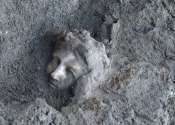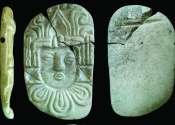Carbon-14, 14C, or radiocarbon, is a radioactive isotope of carbon discovered on February 27, 1940, by Martin Kamen and Sam Ruben at the University of California Radiation Laboratory in Berkeley, though its existence had been suggested already in 1934 by Franz Kurie. Its nucleus contains 6 protons and 8 neutrons. Its presence in organic materials is the basis of the radiocarbon dating method to date archaeological, geological, and hydrogeological samples.
There are three naturally occurring isotopes of carbon on Earth: 99% of the carbon is carbon-12, 1% is carbon-13, and carbon-14 occurs in trace amounts, e.g. making up as much as 1 part per trillion (0.0000000001%) of the carbon in the atmosphere. The half-life of carbon-14 is 5,730±40 years. It decays into nitrogen-14 through beta decay. The activity of the modern radiocarbon standard is about 14 disintegrations per minute (dpm) per gram carbon.
The atomic mass of carbon-14 is about 14.003241 amu. The different isotopes of carbon do not differ appreciably in their chemical properties. This is used in chemical research in a technique called carbon labeling: some carbon-12 atoms of a given compound are replaced with carbon-14 atoms (or some carbon-13 atoms) in order to trace them along chemical reactions involving the given compound.









